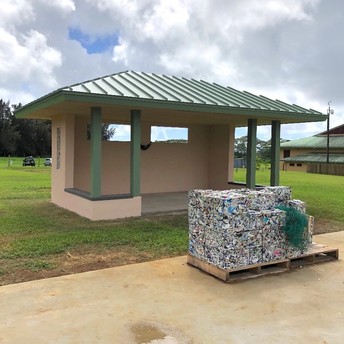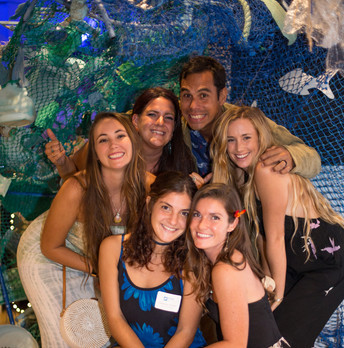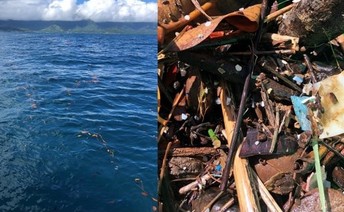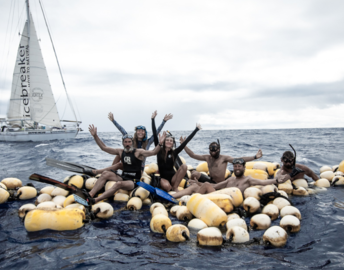| Header Photo: Derelict fishing nets recovered from the Papahānaumokuākea Marine National Monument (Photo credit: NOAA).
 A 12’ x 20’ pavilion constructed from ByFusion ByBlocks at Island School on Kaua'i (Photo credit: Surfrider Kaua'i).
Submitted by: Carl J. Berg, Surfrider Foundation Kaua'i Chapter
The Kaua'i Chapter of Surfrider Foundation removes and weighs approximately 5 metric tons of marine debris from the coastline of Kaua'i each month.
We want to remove plastic from the environment while at the same time capitalizing on the intrinsic value of it. We partnered with ByFusion to test the feasibility of taking a sampling of Kaua'i’s derelict fishing gear and plastic domestic waste to create ByBlocks.
Together, we joined with Island School to build an athletic pavilion on campus. This is the first permanent structure built of ByBlocks in the world.
Learn more about this project and technology here.
 A mass of ghost nets being pulled aboard the sailing cargo ship KWAI (Photo credit: Ocean Voyages Institute).
Submitted by: Mary Crowley, Ocean Voyages Institute
Ocean Voyages Institute removed 84,000 pounds of toxic ghost nets and plastics from the North Pacific Subtropical Convergence Zone, in June 2019, via the sailing cargo ship KWAI. GPS satellite trackers attached to nets by vessels voyaging through the Gyre area enhanced our effectiveness. We are collaborators in the NASA-funded FloatEco program.
In 2020, we are scaling up to remove 840,000 pounds. We welcome anyone who is voyaging through the Gyre to utilize our GPS satellite trackers.
Contact us at +1 (415) 332-4681 and visit our website to learn more.
 The 17th Annual John Kelly Awards will take place on November 16 (Photo credit: Carena Philips).
Submitted by: Doorae Shin, Surfrider Foundation O‘ahu Chapter
The John Kelly Awards is Surfrider Foundation O'ahu Chapters' Annual Awards ceremony and fundraiser dinner. The event is on Saturday, November 16, from 6:00 pm - 10:00 pm at beautiful Waimea Valley. There will be music by Henry Kapono and Noelani Love as well as an incredible silent auction and dinner. The event will award and recognize a Surfer, Lifetime Achievement, Community Wavemaker (non-profit), and Local Business dedicated to protecting our ocean.
Find info and details at johnkellyawards.com.
 A line of debris defines the convergence zone (left). A neuston sample of the debris reveal high concentrations of microplastics amongst the debris (right) (Photo credit: Jenna Karr).
Submitted by: David Field, Hawai‘i Pacific University
Hawai'i Pacific University students recently sampled a convergence zone on windward O'ahu with a neuston net. CTD (conductivity, temperature, and depth) profiles indicate that denser oceanic waters are subducting underneath the lower salinity (less dense) waters around Kāneʻohe Bay. This convergence results in huge accumulations of floating debris, organic matter, microplastics, larval fish, plankton and more, all interacting in a narrow strip of the ocean. Master's student Jenna Karr will determine how much microplastic is being consumed by larval fish.
 The Vortex Swim crew investigates a massive raft of foam floats in the Great Pacific Garbage Patch (Photo credit: Corbin Marshall).
Submitted by: Drew McWhirter, The Vortex Swim
The Vortex Swim is an 80-day sailing and swimming expedition through the Great Pacific Garbage Patch to study and document the highest concentration of plastic in the world’s ocean. A comprehensive study of plastic pollution was conducted, encompassing concentrations of plastics scaling from microscopic fibers to large ghost nets, along with the documentation of associated marine life. This project is in partnership with researchers from the University of Hawai‘i, Hawai‘i Pacific University, Scripps, NOAA, and more.
 Nets removed from Kāneʻohe Bay, O'ahu, in October 2019 commissioned by the Ocean Voyages Institute (Photo credit: Ocean Voyages Institute).
Submitted by: Clifford Inn, DOBOR
The Department of Land and Natural Resources (DLNR), Division of Boating and Ocean Recreation (DOBOR) would like to recognize the Ocean Voyages Institute for commissioning the removal of more than 12,000 lbs. of derelict fishing nets in Kāneʻohe Bay during the week of October 7, 2019. The operation was conducted in collaboration with Mr. Hank Lynch, who has been active in removing nets in this waterway for many years, and with the blessing of DLNR’s Division of Aquatic Resources.
For more information please visit: www.oceanvoyagesinstitute.org/.
 A helicopter helps to transport removed marine debris (Photo credit: Surfrider Kaua‘i).
Submitted by: Barbara Wiedner, Surfrider Foundation Kaua'i Chapter
Over the last few months, Surfrider Foundation Kaua‘i Chapter focused on cleaning a remote beach on the East Side of Kaua‘i through nine cleanups. The area was a hard to reach coastline was littered with fishing gear and plastics. Access to this area required volunteers to hike in. Fifty-five super sacks, that weighed about 155 lbs. each, were filled and larger debris items gathered. This effort by Surfrider Kaua‘i volunteers was led by Scott McCubbins and included youth groups and visitors. Donated helicopter, heavy equipment, and hauling support removed the debris from the area. The total haul was approximately 9,000 lbs.
Mahalo to the numerous volunteers, community members, and businesses that helped with this effort in true Kaua‘i style.
 |